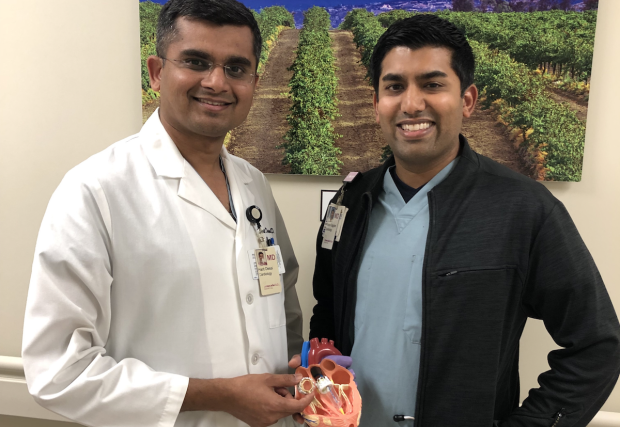Temecula Valley Hospital Performs First TAVR Procedure

Pictured are the cardiologists who performed the first TAVR procedure at Temecula Valley Hospital, Dr. Harit Desai, and Dr. Rahul Gaglani.
Patients who suffer from severe aortic stenosis, which is the narrowing of the heart’s aortic valve opening that restricts blood flow, now have a new option available at Temecula Valley Hospital. The first transcatheter aortic valve replacement (TAVR) procedure was performed this past week at the hospital. TAVR is an advanced heart valve replacement procedure that offers new hope to patients who have aortic valve stenosis. It is a minimally invasive procedure, which can help dramatically reduce patients' recovery time.
"We are very pleased to offer this revolutionary procedure to replace a defective heart valve without open-heart surgery to our patients locally,” said Dr. Harit Desai, who is on the medical staff at Temecula Valley Hospital and performs the TAVR procedure. “Only a few hospitals have the capability to perform this advanced procedure, and this milestone highlights our commitment to our community."
The cardiovascular program at Temecula Valley Hospital provides comprehensive heart and vascular care, including the diagnosis, intervention and advanced treatment of a wide range of conditions, including heart attack, peripheral artery disease, deep vein thrombosis, heart rhythm disorders and aortic stenosis.
Learn more about the TAVR procedure >
Aortic stenosis is a common heart condition caused by the narrowing of the heart’s aortic valve due to a buildup of calcium deposits. When the valve narrows, it does not open or close properly, which makes the heart work harder to pump blood through the body. This can cause the heart to weaken and function poorly, which can lead to heart failure and an increased risk for sudden cardiac death.
TAVR is catheter-delivered aortic heart valve replacement. There is no need for a heart-lung machine because the procedure is performed while the heart is beating. A TAVR valve is made of biological material and is supported with a metal stent. A catheter is advanced into the pumping chamber of the heart under direct guidance using various imaging techniques. The heart valve is compressed and placed on a balloon catheter. The valve is positioned inside the diseased aortic valve. The balloon valve is then inflated to secure the valve in place.
“It’s very exciting for TVH to be able to offer this advanced cardiac care option and state-of-the-art technology to the community we serve,” said Darlene Wetton, Chief Executive Officer, Temecula Valley Hospital. “We continue to grow our cardiac program and I am proud that our hospital has comprehensive cardiovascular services for our region.”
